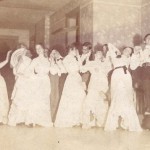In June 2006, the Honda Corporation gave Indiana history buffs—not to mention economic forecasters—something to talk about. When officials at the Japan-based car manufacturer announced plans for the construction of a new vehicle assembly plant in Greensburg, Indiana, their promotions team produced a distinctive image. Banners declared “Home Sweet Honda” on top of an image of Greensburg’s historic downtown. The city’s identity was unmistakable: the burst of green in the banner’s upper left corner was the city’s famous tower tree.
One hundred ten feet up, the roof of the Decatur County Courthouse has sported a tree or two for over a century. The Romanesque Revival-style courthouse dating to the mid-1850s replaced a series of structures that had served that purpose since 1822, when the county commissioners first met in a log home. By the early 1870s, Greensburg residents noticed a green sprig sprouting from the northwest side of the courthouse clock tower. A subsequent inspection revealed a veritable rooftop grove—five saplings flourished atop the tower with no apparent source of nutrition until 1888, when structural concerns prompted the removal of several of them. Since then, the courthouse roof has provided the substrate for a series of trees—the largest reaching fifteen feet in height and five inches in diameter at its base.
Though one of its predecessors was identified by the Smithsonian Institution as a large tooth aspen, the tree that graces the tower these days has been determined by Purdue forestry experts to be a mulberry. The tower trees have been incorporated into the city’s iconography since the early twentieth century, appearing on postcards and in promotional literature. Greensburg has held the Tree City Fall Festival since 1980. The courthouse underwent a major renovation and expansion in 1994, during which the arboreal icon remained undisturbed.





















